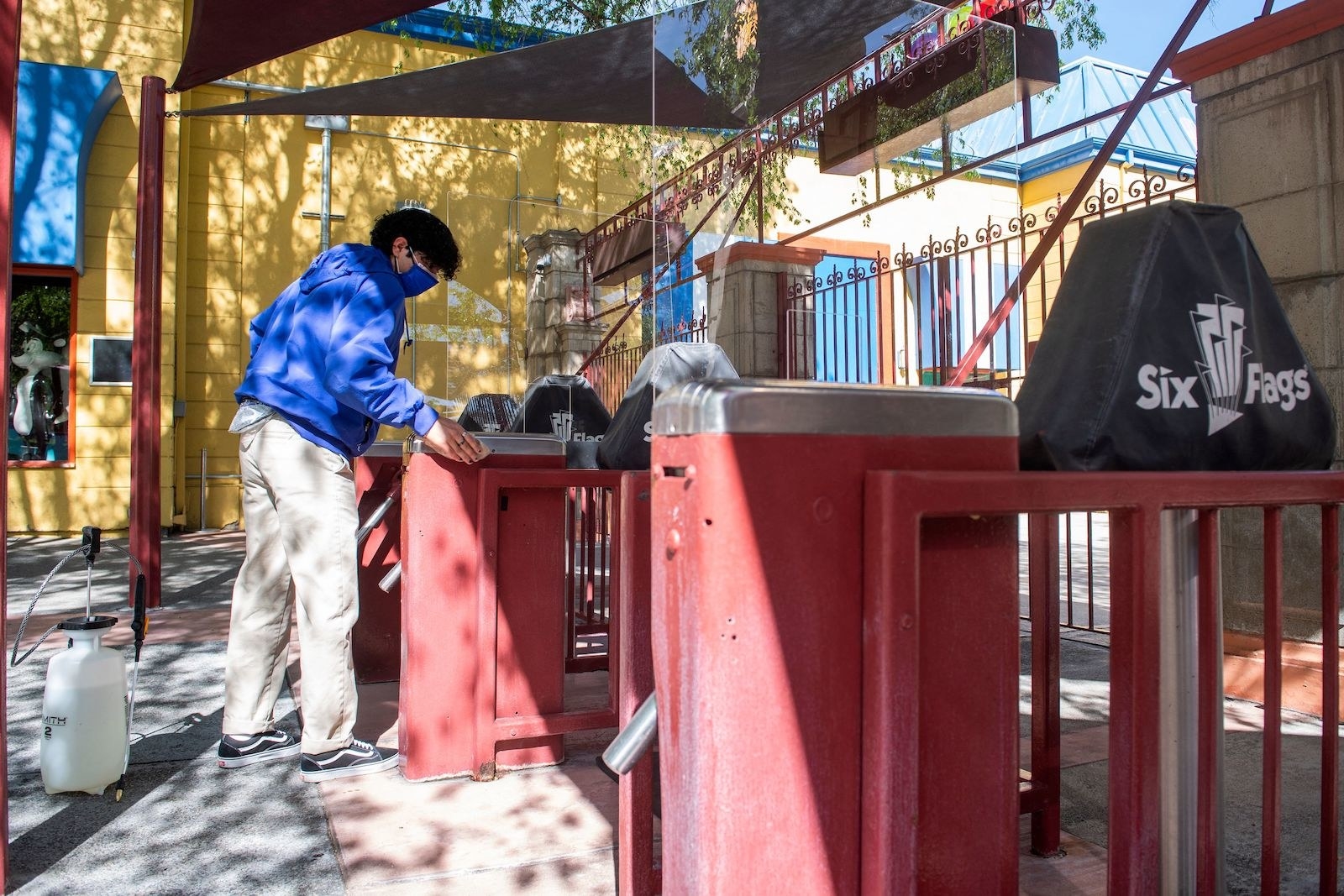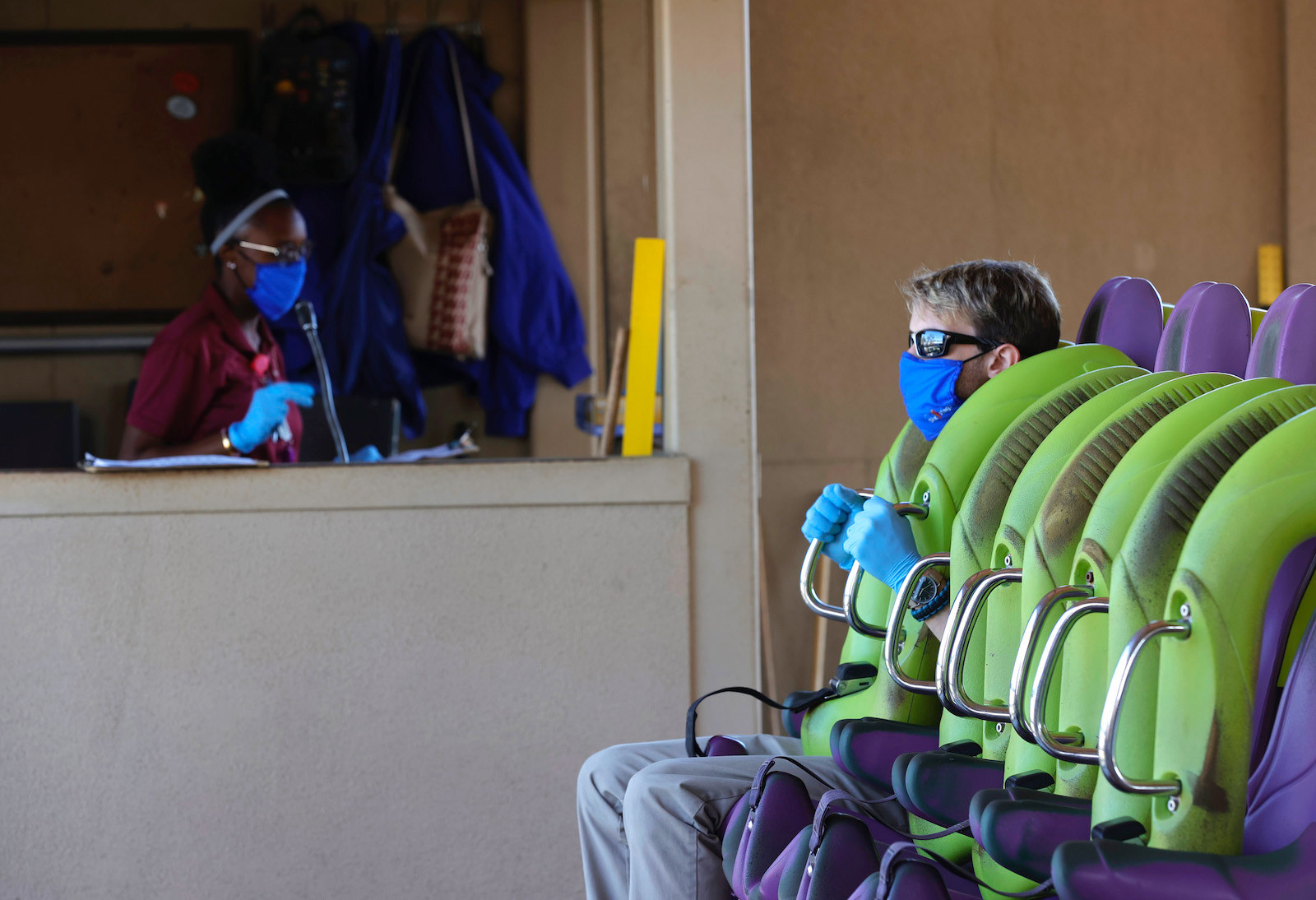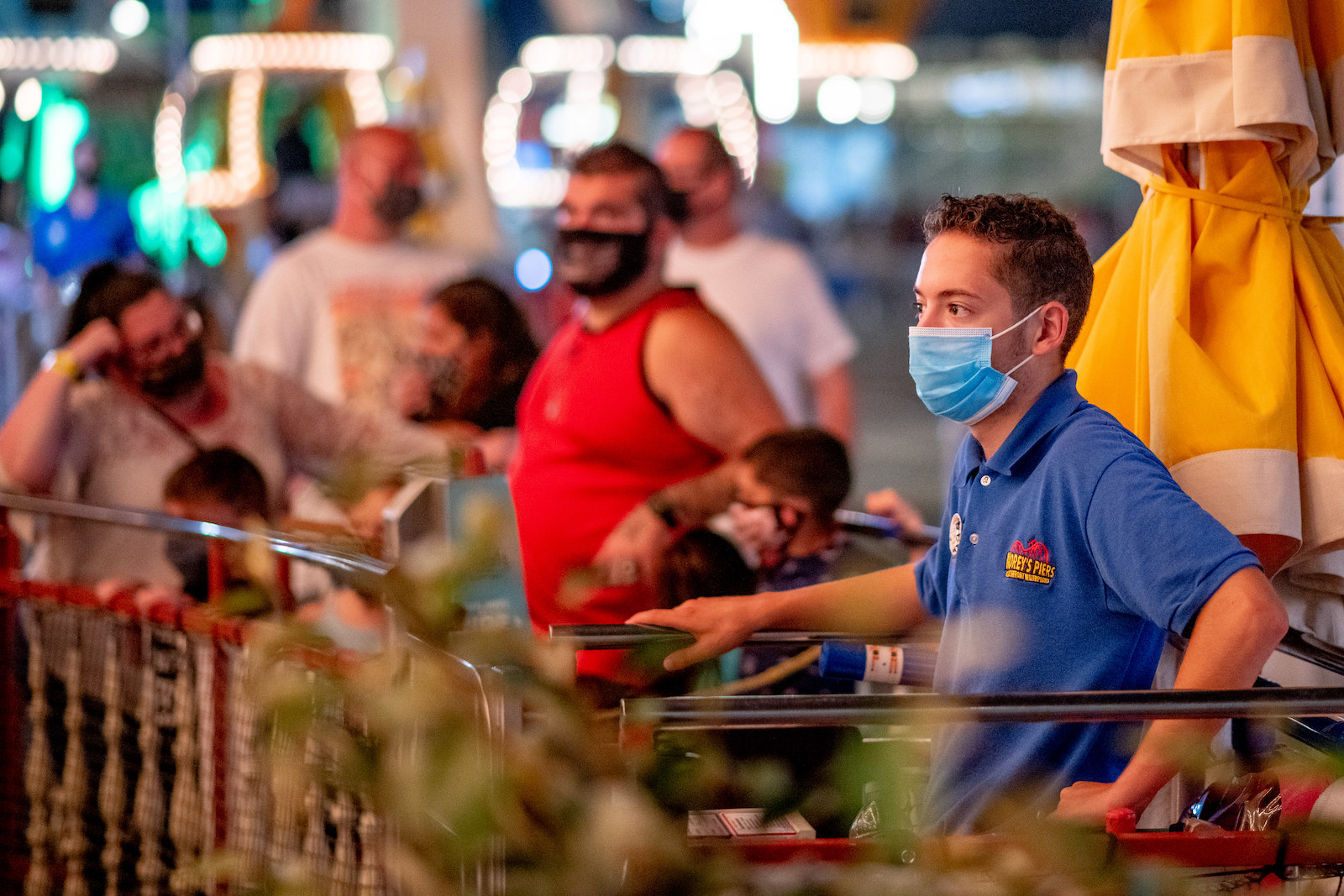There were few things Ethan Lindenberger didn’t like about his part-time job. Working in the arcade at an amusement park in Ohio, the college student played virtual reality games on his breaks and bonded with coworkers, some of whom are now his closest friends. He excelled at communicating with customers, selling passes, and repairing the machines, especially when they ran out of tickets.
Once, he said, the park introduced a friendly competition among employees to encourage guests to post Facebook reviews of the arcade — workers were offered a small monetary reward for each review they prompted — and so many of the reviews could be attributed to him that management limited his payout, which would have totaled $800. Within a few months of starting the job in fall 2019, Lindenberger, 20, was promoted and began training other new hires. “I was really, really good at my job,” he told BuzzFeed News, “and really enjoyed it.”
But in late March 2020, as Ohio Gov. Mike DeWine issued a stay-at-home order to curb the spread of COVID-19, the park, along with all other nonessential businesses in the state, was forced to close. Lindenberger was one of the 125,000 amusement park workers nationwide who were furloughed. He recalled talking with a coworker early in the winter about the possibility of the coronavirus reaching US soil. “All of a sudden, it went from ‘You think this could be a problem?’ to ‘Sorry, guys, go home,’” he said.
The park reopened to the public in June 2020, and his first shift back was scheduled. Concerned that he’d lose his unemployment income if he didn’t accept the work — in Ohio, people aren’t entitled to unemployment benefits if they are capable of working and offered “suitable employment” unless certain exceptions apply — he said he made the choice to return out of necessity. “I was like, OK, well, I'll go back and check it out [and] see if they're handling things safely,” he said.
Upon his return, Lindenberger said he saw crowds of maskless attendees clustering together and standing in line, shoulder to shoulder. He said the park’s capacity was hardly restricted, and when he brought his concerns to management, he said he was told he could approach guests and instruct them to mask up. He felt the guidance was too little, too late. “In order to do the work, you had to be very close to people and listen to them over the loud machines,” he said. “And because of how busy it was, you were constantly being engaged with large groups of people that were not wearing masks at all and the only practical answer was, ‘Oh well, just maintain your own personal comfort and safety.’” He quit the next day. If it weren’t for what Lindenberger considered a disregard for employees’ safety, he said, he would’ve continued to work at the park.
“You were constantly being engaged with large groups of people that were not wearing masks at all”
Thanks to the warmer weather and school breaks, summer is a crucial earnings period for amusement parks. Save for destination parks like Disney World and Universal Studios, most only open during those few key months. Cedar Fair, which owns and operates over a dozen amusement parks nationwide, reported a 6% revenue increase in 2019, fueled by high attendance during peak season, which runs from July to October. Between July and September 2019, Six Flags parks across the country saw 14 million guests, a 3% increase from the year prior. On the whole, attendance for the top 20 amusement parks in the US increased by 1% between 2018 and 2019, according to the Theme Index and Museum Index: The Global Attractions Attendance Report, signaling a stable market for thrills.
The curated magic and illusion of these parks and the shock and delight of their dramatic rides promise a much-needed break from reality. After the last year, when people were largely stuck at home, there’s now a robust demand for travel and leisure. According to a March 2021 survey from Cardify, a data analysis firm, 72% of respondents were excited to return to amusement parks. Intent to visit Disney properties, the most popular parks in the country, has rebounded to pre-COVID levels, according to company executives.
Naturally, workers are also in high demand to preside over the fantasy. Cedar Point, a Cedar Fair–owned park in Sandusky, Ohio, announced that, due to labor shortages, it would close two days a week. In Wildwood, New Jersey, boardwalk attraction Morey's Piers needed to fill 1,500 positions before Memorial Day weekend. Carowinds, a water park in Charlotte, North Carolina, delayed its season opening, citing a lack of workers. A water park in Baton Rouge, Louisiana, put out 700 summer job postings, and Six Flags locations nationwide have struggled to fill their rosters.
Labor shortages have affected many industries in the past year, from hospitality to construction, but amusement parks face specific challenges in attracting talent. COVID-related immigration restrictions have greatly limited the number of foreign workers entering the US, and a dwindling number of people are willing and able to accept the grueling requirements of seasonal work amid a lingering pandemic. As a result, amusement parks are trying to entice employees via sign-on bonuses and other incentives.

Former and current employees, on the other hand, are reevaluating their worth and advocating for better wages. They’re also considering other opportunities that align more closely with their interests and ideologies. “I could pull up job [listings] and find much better jobs than [amusement parks] with much better pay at the same time,” Leticia Rutkowsky, a 23-year-old who used to work at an amusement park, told BuzzFeed News. “I think a lot of people are seeing that too.”
According to consultant Dennis Speigel, founder and CEO of International Theme Park Services, the greatest hiring obstacle is federal pandemic unemployment income, providing jobless Americans an extra $300 weekly. Speigel believes there are potential workers in high school and college who are deliberately avoiding seasonal jobs because they can make more money collecting unemployment. “I think they’re sitting in their basement right now playing with their Wii box and their Xbox,” he told BuzzFeed News. As for the part-time workers who aren’t collecting unemployment, Speigel said, they’re choosing jobs that pay marginally more than amusement parks even if it means spending their days inside hot kitchens, for example, instead of outdoors.
Despite many Republican politicians giving credence to the opportunistic unemployment theory, some workers are arguing that amusement park jobs can be physically laborious, can require a lot of training, and should be better paid. Shortly after a Texas park announced it was reopening in late June 2020, Rutkowsky applied for a job as a ride operator for $10.50 an hour. She told BuzzFeed News she was initially trained to operate six rides — double the responsibility of more experienced employees — and, as a result, made many mistakes.
Rutkowsky’s responsibilities grew to include COVID-19 sanitation a few weeks after she was hired. She said this meant carrying a 2-gallon jug of disinfectant around the park, slung on her back like a bookbag, to disinfect high-touch areas and rides. By the end of her shift, she was exhausted and the skin on her shoulders was irritated by the friction. “I wanted a simple summer job,” Rutkowsky said. “Honestly, I don’t feel like I was making the money that I needed. What I was doing was not worth the pay. I don’t have any hatred for [the park]; they’re very cautious. I will admit they did really good at that, but at the cost of the workers.” She put in her two weeks’ notice and got a new job as a substitute teacher about a month later. Substituting better suited her interests and training — she studied teaching at college — and she would no longer need to stand in the sun all day.
One former worker at a Florida amusement park, who asked to remain anonymous, said they had enjoyed their job as a turnstile operator for three years. But after the park reopened in June 2020, they said, maskless guests berated them; they said they believed the park surpassed the 50% capacity for guests. (Despite fears of theme parks becoming superspreading locations, Disney, for instance, has reported no outbreaks among guests and workers.) Although the employee said their hourly wage was raised to $10 an hour (a $1 increase), they left a few months ago to take a job at Target. “Less people,” they said.
As states began reopening last summer, the chasm grew between workers who could safely do their jobs from home and those in the service industry, like line cooks, grocery store clerks, and amusement park employees, who often receive low hourly wages without health insurance or paid time off. The ensuing national conversation surrounding low-paid work (the average hourly rate for an amusement worker is around $14) and the campaign for a $15 federal minimum wage has empowered many people to rethink what they’re entitled to in the workplace.
For Lindenberger, the former arcade employee, this labor shortage comes down to employees feeling emboldened to push back against undesirable conditions. “I think with that first initial wave of reopening — seeing that there were no precautions, no health guidelines, no one was enforcing masks — [workers] said, ‘Wait a second, this is not fair. You're telling me to go back to work, but you're not going to make sure people aren't going to get me sick?’” he said. With the nationwide vaccine rollout, a second wave of businesses tried to recruit former employees without raising their wages. “Companies are clearly prioritizing their revenue over the lives of their workers, and be that in a health and medical context or a financial context, it's still the same,” he said.

Another traditional employment avenue has also dried up in the past year. Last June, then-president Donald Trump signed an order banning workers from outside the US from entering the country on a work visa through the end of 2020 as a COVID-19 mitigation effort; the ban was extended through March 31, 2021. Included in the freeze were J-1 visas, which enable migrants to take seasonal work in the US. President Joe Biden has since let the order expire, but the freeze has had a ripple effect.
Over the last two decades, amusement parks and seasonal attractions have come to rely on J-1 workers; they are generally students from outside the US who acquire summer jobs in sectors like retail and leisure and hospitality. According to a 2019 report from the International Labor Recruitment Working Group, 20,000 people with J-1 visas were hired to work in the US during summer 1996; that number ballooned to over 100,000 in 2018. In tourist destinations with small populations, outsourcing talent is often the most effective solution. “A lot of the American [workers] are more part time,” Cory Hutchinson, the general manager of Saco, Maine, amusement park Funtown Splashtown USA, told BuzzFeed News. “We depend on these kids with the J-1 visas because we know they want 40 hours a week. They’re going to be here for four doubles a week, every single week. They’re going to be here at 10 when we open and they’re going to be here at 9 when we leave.”
At its hiring peak in 2019, Funtown Splashtown USA employed 108 workers through the J-1 visa program. So far this year, it has hired fewer than 40. Under normal circumstances, Hutchinson said, he would begin recruiting J-1 workers in December and January by attending job fairs in countries like Turkey, Poland, and Germany. After the students receive a job offer, they must be interviewed at their respective country’s US embassy. Hutchinson said his J-1 employees usually have these interviews in February or March. But because the US didn’t resume issuing J-1 visas until April, potential hires were unable to secure embassy interviews until after, pushing back the process several months. Increased demand and a backlog of applications also caused interview delays.
“I wanted a simple summer job”
In late April, hundreds of organizations that hire J-1 workers wrote Secretary of State Antony Blinken, urging the government to waive interviews for the applicants; subsequently, the requirement was waived for some who had previously been granted a J-1. Still, the delays ate into the summer work season, potentially deterring some student workers from coming to the US altogether. “They want to work that full 12 weeks they can work,” Hutchinson said. “They’re not interested in coming and working seven weeks.”
Because of remaining holes in staffing — Hutchinson said the park needed anywhere from 150 to 200 new hires to be at full capacity — Funtown Splashtown USA will only open five days a week this summer. In order to encourage potential employees, the park has raised hourly wages from $12.15 to a minimum of $14.50.
Staffing is always difficult at New Jersey boardwalk attraction Morey’s Piers, said Denise Beckson, the park’s vice president of human resources, but this year she needed to get creative. To start, the company raised its hourly wage from $12 to $15. She then promoted listings through the National Puerto Rican Chamber of Commerce and a job board for college students. Morey’s Piers also partnered with a local technical school, which encouraged students to apply, and a New York casting agency that placed 70 singers, dancers, and actors at the boardwalk. Many of the season’s employees will be carrying out dual roles. “Someone might be the cashier at the pizza stand and in addition to cashiering, there’s going to be performance or engagement within that,” Beckson said. The CFO of Morey’s Piers will sell tickets, and its lead carpenter will work a concession stand grill.

Morey’s Piers truncated its 2021 summer season, reaching full operating capacity in mid-June, as to limit the number of workers needed during difficult-to-staff fringe periods like late spring. This gave Beckson more time to fill out her rosters. Heading into Memorial Day weekend, the park was about 75% staffed. “It doesn't come close to 2017 numbers, but every single person matters,” Beckson said.
The lingering effects of the pandemic aside, many industries will continue to face obstacles in recruitment, said Jeffrey Korzenik, chief investment strategist at Fifth Third Bank and author of Untapped Talent: How Second Chance Hiring Works for Your Business and the Community. “Let’s not forget the big demographic picture, that the millennial baby boom is already in the workforce and that birth rates peaked in the US in 1990,” he said. Prior to the pandemic, experts had predicted waning birth rates would result in worker scarcity. As births continue to decline, fewer teens will be available to work summer jobs at amusement parks.
When there are more job openings than job seekers available, that creates what Korzenik described as a hot labor market. In order to attract applicants, businesses might need to offer more than cash bonuses. Since many amusement parks tend to be in remote or tourist-driven areas, Korzenik suggested, they could provide employees with housing, transportation, or on-site childcare. He cited a seasonal business he consulted on Nantucket Island that chartered airplanes to shuttle employees from the mainland. “That might be something that businesses have never had to consider but have to consider now,” Korzenik said. “Employers are going to have to be more creative and flexible than ever before.”
Such amenities could help retain employees. C.E., a 29-year-old who asked to be identified only by her initials, used to work at an amusement park in Ohio that offered free employee housing. She moved there from Detroit in 2017 to work part time as a busser. When the pandemic hit and the park closed, C.E. sheltered in place, first at one of the complex’s fully equipped apartments and then moved to a kitchenless residence. By June 2020, when the park was set to reopen, C.E. said, she was told she would need to begin paying rent, which she couldn’t afford on her wage of $10 an hour, so she returned to Detroit to live with her parents. “The main reason I don’t want to go back there is the housing situation,” she said.
Like any other industry, amusement parks rely on their workers. Even if demand exists, these attractions can’t cater to their usual number of guests without the required workforce. With immigration only inching back to its former levels, businesses are scrambling for staffers. And until workers feel they’re being adequately compensated for labor in the sweltering summer heat, the amusement park life will be a harder sell. “They're refusing to work because they see that their labor, their work, is not ever getting back to them,” Lindenberger said. “They're not seeing any matching increase in wage. That's not lazy; that's people being aware that their work is being exploited.” ●

